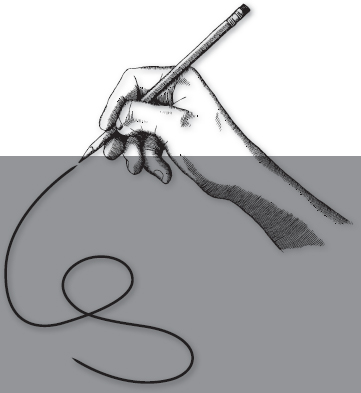
The strokes that are made by the writer at the beginning and at the end of each word need to be taken into consideration in any handwriting analysis, as this trait indicates the amount of preparation, if any, that this person requires before going into action. Whether the script is unnecessary or constructive will reveal whether the writer is likely to finish the task at hand.
As we were taught in elementary school, the writer creates the initial stroke at the beginning of each word written.

Generally speaking, a long initial stroke shows that the writer needs time to make inner preparations before starting anything new. A combination of long initial strokes and a slow pace of writing suggest that the writer is dim-witted. When an initial stroke is fairly long and the speed is decidedly fast, this signifies that the writer gets into the swing of things and maintains the rhythm of activity. A long starting stroke from below the baseline can act as a springboard, but the writing speed must be at least moderately fast for this to be considered a positive factor.
When there is a springboard stroke and the writing is slow, this can indicate that the writer is strongly relating to past ties, to a mother figure, and to the influences of early life experiences. A fast writer, however, is not affected too strongly by events in earlier years.

Writers who dive right in to their script without making initial strokes are unlikely to follow set patterns and methods. They are flexible, and they can adapt to whatever circumstances they find themselves in. They are not fussy or careful and they ignore inessential details. They have a positive attitude to life.

The feeling stroke is another form of graphic hesitation. In this case, writers make a few faint starting marks, which may appear as leading strokes, while they are considering their subject and before they begin to write. These writers normally have a copybook style of script. They lack confidence and rarely achieve much because their hesitation and deliberation impede their efforts. The feeling stroke is rare, however, and it usually belongs to those who seldom need to write anything at all.

This starting stroke can indicate constructive thinking and persistence. It can also, however, indicate an angry response to interruptions.
When the initial stroke rests squarely on the baseline, the writer will take orders from those who are in positions of authority, follow regulations, and conform to what is acceptable to others. When faced with a decision, these people may feel anxious and inadequate. They usually have a copybook form of script.

1. Shows a liberal attitude to others and to change
2. Has a normal disposition
3. An indication of determination, curiosity, and suspicion
4. This can also be a sign of weakness and timidity

1. This type of d can indicate an aggressive attitude
2. Can also be an obstinate individual who likes to be in control
3. Normal social attitude
4. This can show unemotional tendencies
Most writers end their words with a tailing-off stroke, and these strokes can run from a long stroke to an abrupt ending. These tailing-off strokes relate to an interest in others and they may represent a kind of “reaching out” to others. Therefore, an abrupt ending can indicate a boring person or a lack of energy and drive. The lowercase letter e is the best letter to look at, but the letter d is also interesting, as the writer needs to change direction to produce the end stroke before moving on to the next word.